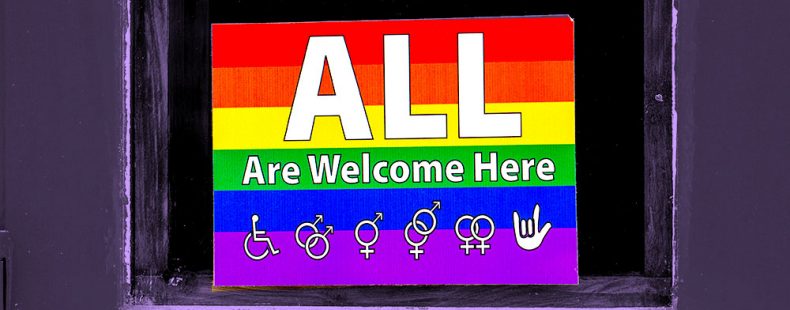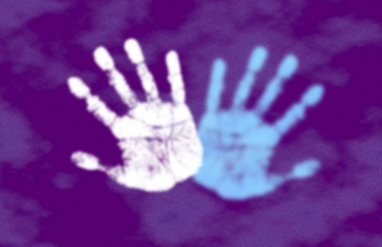Language has many functions. There are the obvious ones, like communication and emotional release. But language can also be used to indicate who is included and who is not. Even the casual, everyday language we use can signal to others that we consider them worthy of respect, consideration, or attention. And there are some easy things we can all do to make our everyday language more inclusive of people from all backgrounds and walks of life so as to communicate this respect. Read on to learn 10 easy ways you can be more respectful and inclusive in everyday language.
1. Use the language people use for themselves.
This is one of the most important guiding principles of inclusive language and respectful behavior generally. A straightforward example of this is that one should use a person’s personal or preferred gender pronoun when referring to them. (You can learn more about personal gender pronouns here.)
However, this principle can be extended to all descriptors. There is a great diversity within communities and not all members of a given community will agree on how they choose to self-identify. The points here are general guidance, but they may not apply in every instance. In general, you should listen to what people say they prefer.
2. Use language that avoids making assumptions about identity.
To paraphrase poet Walt Whitman: People are vast; they contain multitudes. There is a great diversity within communities. There is also great diversity between communities. While you may think you can “just tell” how someone might identify based on their appearance or language, you may end up making some embarrassing and offensive assumptions.
Let someone share with you how they identify in their own time. (A question like “Where are you from?”—while well intentioned—may imply an assumption that someone is an immigrant based on their appearance.) Use language based on common experiences or context. For example, in a work setting, it might be appropriate to ask, “How long have you worked here?”
3. Use gender-neutral language when talking to or about groups.
Using gender-neutral language when addressing a group helps ensure that you do not assume the genders of the people involved. This is helpful in more than one way. Not only is it inclusive of nonbinary people, it also prevents reinforcing stereotypical and outdated gender roles. Three easy ways to accomplish this are:
- Use inclusive greetings, such as Hello, everyone or How are y’all doing? (as opposed to gendered greetings that include phrases like ladies and gentlemen or boys and girls).
- Use gender-neutral job titles, such as mail carriers instead of mailmen or police officers instead of policemen.
- Use the pronouns they/their rather than he/his or she/her when discussing a group. For example, instead of saying “Everyone needs to bring his or her own water bottle,” you can say “their own water bottle” (or even simply “a water bottle”).
Of course, there are many circumstances when it is acceptable and appropriate to use gendered language, as when addressing a specific audience.
You can learn more about how and when to use gender-neutral language here.
4. Respect preferences around person-first and identity-first language.
Person-first language is the practice of putting the person first, before a descriptor that’s being applied to them, such as in person with a disability. This contrasts with identity-first language, such as disabled person. Other specific examples of person-first language are:
- person with epilepsy
- people with a substance use disorder
- person who uses a wheelchair
Preferences around these types of wording are varied and nuanced, and language around disability, disease, and neurodivergence is constantly evolving. Although there is a strong and established preference for person-first language in many situations, such as in general medical contexts and among many people with disabilities, members of some communities prefer identity-first language. This is notably the case for many deaf, blind, and autistic people, who prefer identity-first language as a way of reflecting what they consider an inherent part of their identity.
As with so many other forms of identifying language, it’s important to always use the language that an individual or community prefers.
You can learn more about some of the nuances of person-first and identity-first language here.
5. Avoid stigmatizing terms like insane and crazy.
Using terms such as crazy, insane, or nuts in a derogatory way contributes to the stigma placed on those who have a mental illness. Fortunately, there are many alternatives to these terms that can be used when simply describing unusual behavior or an unexpected situation, such as:
You can find other preferable synonyms for crazy here.
When describing behavior considered unusual, you can also avoid such adjectives completely by describing it specifically (“They were moving their arms in a jerky fashion”).
Further, when discussing mental illness—when a condition is relevant—it is always preferable to use specific or medical language rather than euphemistic or pejorative terms like crazy. It’s often best to simply use the name of a condition (“She has schizophrenia”).
6. Use unsheltered, unhoused, or houseless.
As we noted in our updated definition of homeless this year, the term homeless is “sometimes disparaging and offensive.” Homeless can imply that a person is without a home even though they may indeed have a home within a community despite being without shelter. Although homeless continues to be widely used, including by people who apply it to themselves, alternative terms have risen in popularity. Here are what the alternative terms mean:
- unsheltered: includes people who sleep in cars and under overpasses, for example, but not people in temporary housing like public shelters
- unhoused/houseless: being without a house
Typically, these terms should be used as adjectives (as in the unhoused community). Use as collective nouns (as in the unhoused) is often considered insensitive due to its tendency to generalize, stereotype, and stigmatize.
7. Avoid black as a synonym for bad.
Think about the ways words like black or dark are used as synonyms for bad. While there are no semantic links between such senses and the sense used to refer to a skin color, their proximity on a dictionary page can be harmful and can lead to unconscious associations between a word of identity and a negative term. For that reason, Dictionary.com updated its entry for the word by adding capital-B Black to separate this sense from the senses historically used for negative connotations (such as how the word is used in black magic).
Of course, there is no shortage of things that can be described as bad or evil. There is also no shortage of alternative synonyms for bad, including:
You can learn more about contemporary definitions of black and Black here.
8. Use trans and appropriate variations.
Language around trans identities is rapidly changing. While historically terms like transvestite, transgendered, or transsexual were once widely used, these terms have since become increasingly rejected by most members of the trans community. In general, when talking to or about trans people, it is preferable to use the adjectives trans or transgender rather than any of these terms. Additionally, the nouns transman, transwoman, and their variations are considered widely appropriate.
9. Use assigned sex.
In the context of trans people and their experiences, the term assigned sex and its variants are preferred. Assigned sex typically refers to the sex listed on a person’s birth certificate. Variants are the acronyms AMAB (assigned male at birth) and AFAB (assigned female at birth). Use of these terms avoids others that may exclude people based on limited historical notions of sex and gender.
10. Use language that acknowledges neurodivergence.
Everyone is different. People have different approaches to work, communication, and creation. Overusing language like “typically,” “in general,” and “normally” in certain contexts can suggest that there is an ultimate “normal.” This tends to exclude people who do things differently, such as due to being neurodivergent, autistic, or simply having a different preference. Furthermore, it ignores the fact that such differences can be positive and important to who a person is.
Using specific language can help avoid making it seem like aligning with a given norm is “correct.” For example, rather than generalizing, you can personalize a situation by saying, “In my experience….” Alternatively, you can articulate specific expectations without alluding to a general norm. For example, rather than implying a norm by saying “Most people can finish six tasks by tomorrow,” you can more clearly set expectations by saying something like “I’d like each member of the team to complete six tasks by tomorrow.” Of course, such language is highly context-specific, but it is a good general principle to keep in mind.
The way we talk to and about each other is a marker of who we take into account and who we exclude. Using these tips and generally being mindful that people come from many different walks of life can help us all be kinder and more inclusive of others.














